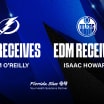96 Points:Understandably, Lightning fans aren't feeling too good right now. The team is coming off back-to-back home losses and allowed six goals in each of those games. What was shaping up to be a positive stretch of seven out of eight games at home - the Lightning had gone 4-1-1 prior to the last two contests - ended with a thud. After 40 games, the Bolts are on the wrong side of the playoff cut line.
Mishkin's Musings: 96 Points & A Tale of Two Uniforms
As the Lightning hit the road, broadcaster Dave Mishkin discusses what the team needs to do to work back into the playoff picture and more.

© Len Redkoles
By
Dave Mishkin
TampaBayLightning.com
What will it take for them to get above that line? First and foremost, they need to improve some problem areas. They've allowed the first goal in 26 of the first 40 contests. They need to reverse that trend in the second half so that they are leading more than they are chasing in games. Their team goals against average must come down. They must find a way to get - and stay - healthy.
They also must finish in the top three in the Atlantic Division - or else claim one of the two wildcard spots in the Eastern Conference. The race right now is a garbled mess. Every team in the East still has a shot to earn at least a wildcard, especially now that slumping Philadelphia has come back to the pack after its earlier 10-game winning streak.
Interestingly, some teams don't measure the playoff race in relation to competing clubs. Instead, they set a "points" goal for the season and then divide that goal into smaller segments. This way, a club is only concerning itself with what it must do, not with what any other team is doing. I noted that Toronto head coach Mike Babcock, in his postgame comments after the Centennial Classic, referenced the Leafs' current five-game segment. He spoke about how the Leafs were three points behind their season-long pace. He wants his team to amass at least six points in each five-game segment. Last season, when the Lightning visited Calgary, then-Flames head coach Bob Hartley (who I know from our days together in Hershey) invited me back into his office to catch up. He had a similar five-game segment chart on his board.
This formula isn't exclusive to just Babcock or Hartley. Regular readers of Boltprospects.com know that in the recap of Lightning games, the website mentions 10-game segments, in which the team needs 12 points to stay on playoff pace. A team that picks up six points in every five games - or 12 in 10 - would reach 96 points after 80 games. Then there are the two final regular season games to pad that total.
Why is 96 considered the magic number? One reason might be that the math works nicely when breaking up the season into smaller segments. But more importantly, history shows us that in recent years, getting to 96 in 80 games virtually guarantees a postseason ticket.
I looked back over the past six seasons (not including the shortened 2012-13 campaign) in both the Eastern and Western Conferences. While the playoff format changed in the 2013-14 season, the number of the teams that qualified stayed the same - eight from each Conference.
During that time, only one team hit the 96-point threshold and failed to make the playoffs. That was the 2014-15 Boston Bruins, who finished with exactly 96 points. The Pittsburgh Penguins claimed the final playoff seed that year with 98 points. After the '14-'15 Bruins, the next closest team to miss was Dallas in 2010-11. The Stars had 95 points that year and were one point away from eighth-seeded Chicago. Of course, had the Bruins or Stars won their two "extra games" in those seasons - they both would have made it.
In most years, the eighth seed didn't even need 96 points. In 2015-16, Detroit qualified as the Atlantic's third seed with 93 points. Minnesota had just 87 points and was the West's second wildcard. Typically, teams finishing with points in the low-to-mid 90s do get in. But it doesn't always happen. That's why 96 in 80 games is a safe bar to set. And, as mentioned earlier, if you hit 96 in 80, you still have two other games to add more insurance points.
By that 12-in-10 standard, where are the Lightning? In their first 10 games, the Bolts went 6-4-0 and got those 12 points. Their record in Games 11-20 was 6-3-1, good for 13 points and a season total one point ahead of playoff pace. Then they took a big hit in Games 21-30, going just 3-6-1. Those seven points were five off the pace and left them with a season net of minus four. They just wrapped up their fourth 10-game segment. With seven out of the 10 games at home, it was a good opportunity for the team to make up ground. But they finished with just 10 points (4-4-2 record) and are now six points off that 96-in-80 pace.
So the Lightning have some work to do in the second half and, more immediately, in the coming weeks. The next 10-game segment is a road-heavy one, with eight of the 10 to be played away from home. The good news for the Lightning is that most of the other Atlantic teams currently are also behind the 96-in-80 pace. As in these other recent seasons, it may not even take 96. But historically, that's a safe number, one that Mike Babcock and other head coaches chase.
A Tale of Two Uniforms:From the serious business of playoff qualification to the frivolous subject of team uniforms. At least it's frivolous to anyone who's not a broadcaster. Regular readers of this column might recall that I've sometimes mentioned the challenges posed by certain uniform color schemes. Most arena press boxes are located at the very top of the arena, far from the ice. So uniform numbers that don't provide a clear contrast to the jersey's main color are hard to see. For example, the New York Rangers' home uniform is a classic jersey, but the red numbers don't contrast much with the blue uniform. Same goes for Edmonton's home jersey with orange numbers on blue.
The New Jersey Devils, on the other hand, have perhaps the best uniform contrast. Big white numbers stand out against their red uniform. A black outline makes the number pop even more.
I'm bringing up uniforms because of the Lightning's two opponents this weekend. Both the Philadelphia Flyers and Pittsburgh Penguins are celebrating their 50th anniversary seasons this year. Last season, the Penguins reintroduced a uniform worn by the team in the 80s and early 90s. It was used as a third jersey for home games - they just wore the black version, not the white one. As the team got rolling in the second half of the regular season, they began wearing that third jersey as their regular home uniform. This year, it's become their main uniform at home and they're now wearing the white version for road games as well. I love this uniform, not only aesthetically, but also as a broadcaster. The black, white and bright gold provide a terrific contrast - I feel as though I could see those numbers from halfway across Pittsburgh.
On Sunday, the Penguins are scheduled to wear their whites, not their usual home blacks, though. That's because the Lightning will be wearing blue for their game on Saturday in Philadelphia. The Penguins agreed to wear white on Sunday, so the Bolts wouldn't have to bring two sets of jerseys on the trip.
The reason why the Lightning will be wearing blue on Saturday is that the Flyers be donning their special 50th anniversary jerseys, which are white. The Flyers also wore this uniform when the Lightning played in Philadelphia on November 19. Like Pittsburgh's jersey, this uniform has gold in it. But it's not a bright, sharp gold. It's a light gold. The numbers are in this light gold. And the uniform, as I just mentioned, is white. Light gold numbers on a white uniform. From a Philadelphia fan's perspective, this jersey probably looks fantastic. But from a broadcaster's perspective, let's just say that this color scheme is umm … not ideal.


















